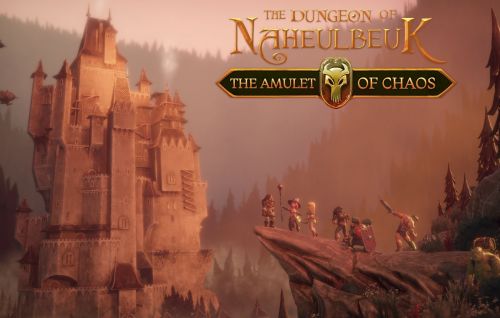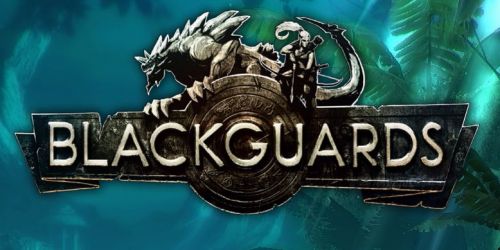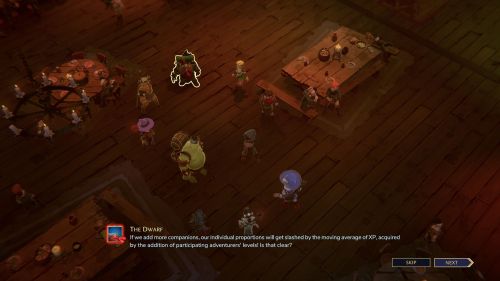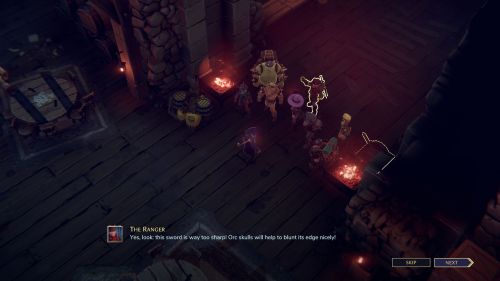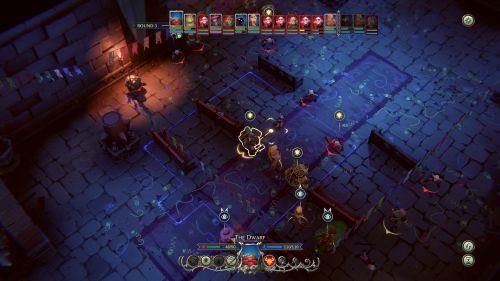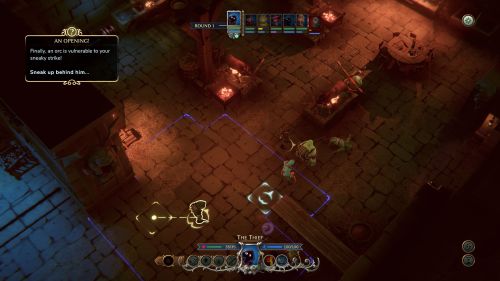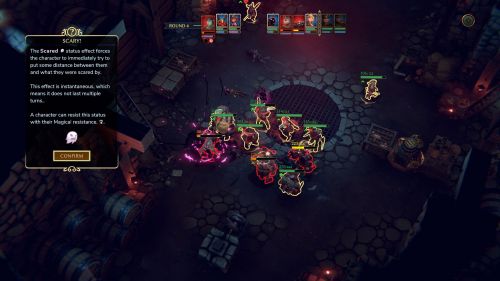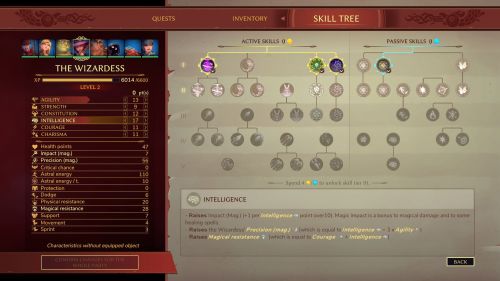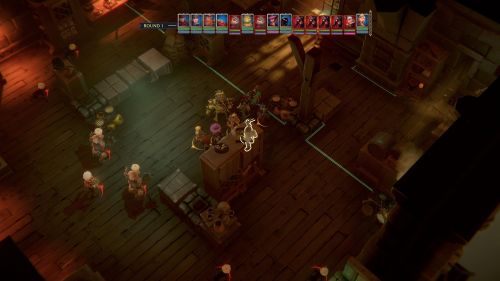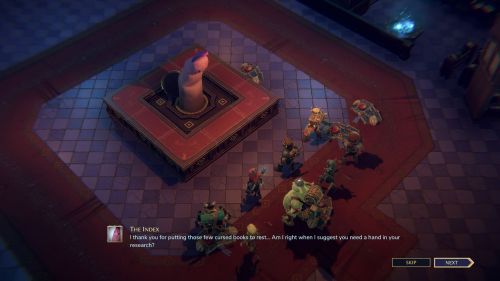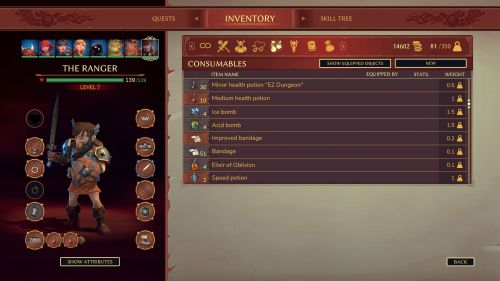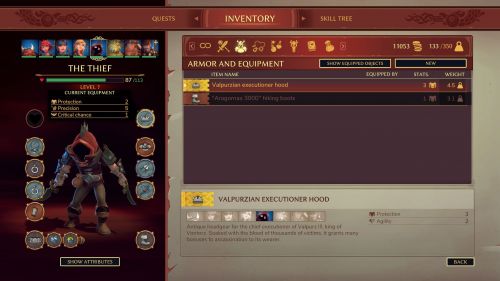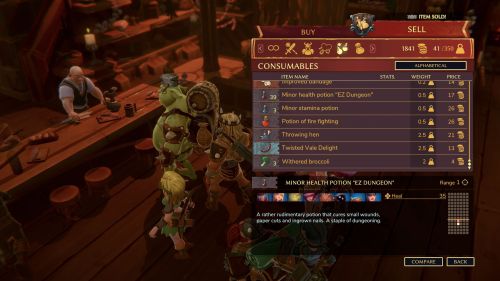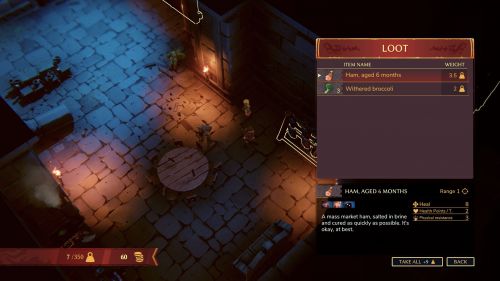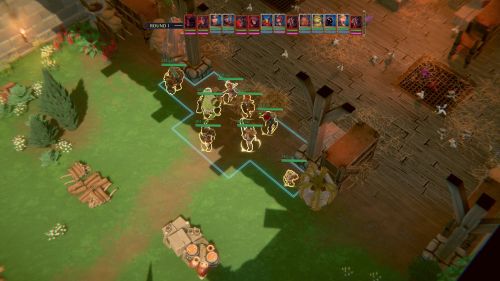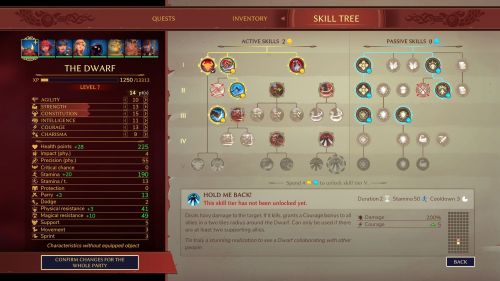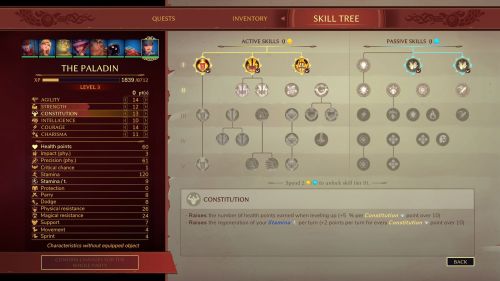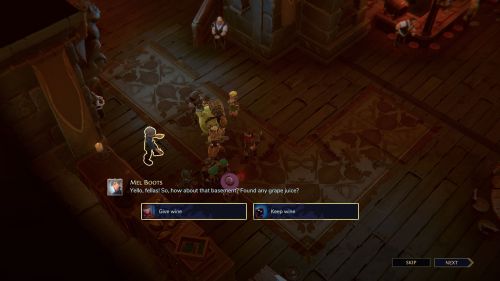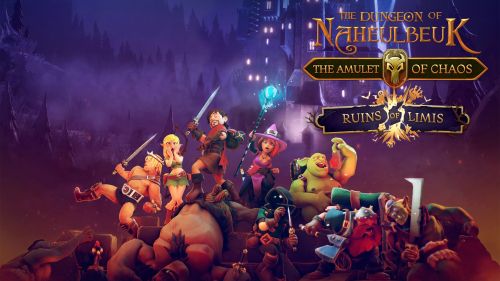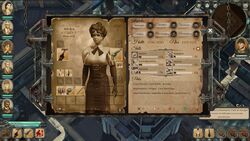RPG Codex Review: The Dungeon of Naheulbeuk
RPG Codex Review: The Dungeon of Naheulbeuk
Codex Review - posted by Infinitron on Sun 11 July 2021, 14:17:23
Tags: Artefacts Studio; The Dungeon Of Naheulbeuk: Ruins of Limis; The Dungeon Of Naheulbeuk: The Amulet Of Chaos[Review by Grunker]
Dungeon of Naheulbeuk Review: Great combat, poor poultry puns
This odd period of oldschool revival and nostalgia has certainly offered its fair share of disappointments. It’s safe to say that most Kickstarters promising a golden return to the full-fledged, epic-scale RPGs of decades long since passed have been met with a resounding ‘meh’ from most of the prestigious gentlemen frequenting this esteemed website. Even if I don’t hesitate to call a few of those games ‘great’ – notably Pathfinder: Kingmaker, Underrail and Pillars of Eternity: The White March – I find myself at least agreeing that many of the games that have tried to recapture the greatness of older RPGs have failed to do so. Obvious examples include Wasteland 2 and Shadowrun Returns, and they are headliners from a long list of disappointments rather than exceptions.
On the flip side, however, this period has also granted us a handful of downright excellent, hyper-focused hybrid RPGs. Perhaps it is the Codex's penchant for focusing on the negative, or maybe just the fact that our users are less interested in non-purist RPGs, but I feel that these gems are underappreciated here, with forum threads too short and playerbases too small.
In fact, some of these games have made fairly triumphant attempts at breaking into my Top 10 Games of All Times list. I often jokingly assert that Daedalic Entertainment’s ‘Blackguards’ was the best game of its decade, for instance, because despite a flawed character system, awful itemization and a forgettable story, it delivered 40-50 hours of some of the best goddamn RPG combat - and, more importantly, encounter design - I have ever experienced in my long life playing these kinds of games to death. The game stands as a testament to how much you can accomplish with sparse resources and a small team, IF your game has a narrow scope and sets out to do just a couple of things, but does them very well.
Just to name a few examples of such games: Knights of the Chalice, Battle Brothers, Jupiter Hell, Urtuk: The Desolation, Lords of Xulima, Gloomhaven, FTL: Faster Than Light, Transistor and of course, the actual best game of Blackguards’ decade: Disco Elysium.
In light of such pleasantly surprising glory, I find myself disagreeing more and more with Vault Dweller’s old assertion that only “full-scale RPGs” (loose quote based on memory) matter. On the contrary, I feel that in the past 10 years or so, my most fond memories have been with these games, and my praise for them has been undiluted by the ‘buts’ that often plague the compliments I pay to good, larger-scale RPGs.
One of these fond memories is Artefacts Studio’s ‘Dungeon of Naheulbeuk’, which despite its narrow scope, steep asking price and completely unwieldy, unmarketable title, offers a solid tactical RPG-experience for anyone who might be a weird enough fuck to enjoy that sort of thing.
Our roster of roosters
The core thematic conceit of Dungeon of Naheulbeuk is also its most hit-or-miss aspect: being a parody of a pen & paper roleplaying session. You take control of a stock party of stock characters with the slightest of satirical spins: a “brave” ranger who is more self-interested than his role as the selfless party-leader would dictate, a vain, “dumb blonde” elf with a cleavage large enough to murder a midget by means of asphyxiation, a cowardly thief with paranoid delusions, a greedy dwarf who antagonizes the elf and gets antagonized in return, a wizardess whose role as the group's "straight man" gets undercut by the fact that she is oblivious to her own follies, a gluttonous ogre who speaks Wookie and thus needs the wizardess to translate, and a braindead barbarian who spouts chants to Crom and says stuff like "Awesome!" in a brodude voice. About half of the game’s main, narrative attraction – its humor – are puns on common RPG tropes or satire over something that might happen during a P&P session, while the other half remains in the “things that are funny by themselves if you have yet to reach adulthood” category: farts, asses, toilets and a weird fascination with poultry (maybe it's a French thing?). The jokes of the former category can sometimes succeed in prompting slight giggles and even a few outright laughs when they happen to be inventive or surprising enough, which is not often. Most of these jokes you will already have heard from your friends during late night sessions of D&D, and every single one of the latter falls flat. I’m not kidding when I say there is a joke about an actual toilet location in the game on almost every floor of the titular dungeon. It gets old before the first time.
The game couples its fairly basic humor with an efficient but oft-times dubious translation, and while the casting of its voice actors is great, the direction is all over the place leading to audio-based Uncanny Valley-esque acting with lines often being delivered with odd rapidity and no situational awareness or timing.
While those codexers who think transsexuals in video games threaten to devastate the nuclear family and undermine the structural cohesion of the entire western civilization will find the game’s humor mercifully unrestrained by the politically correct standards of most entertainment today, the fact is that both the narrative and the humor are just kind of boring and cliché most of the time. While it might be nice to see something without Twitter's enraged politbureau's stamp of approval slide past censorship, it's simply a shame that the writ of passage wasn't used for anything worthwhile.
As for the graphics, they are cartoony but functional, while the UI is competent and serviceable but also mostly basic. As such, none of these things are really worthy of discussion.
What is, however, is the gameplay.
A tactical game of chicken
The way Dungeon of Naheulbeuk is designed to play is ultimately the reason why I will end up recommending a purchase - even at its admittedly high price of 35 of the European Union's rainbow dollars. You control no fewer than 8 characters – the seven members of the core party as well as one additional party member you pick up later – in a tactical hybrid of oldschool RPG combat and modern, nu-XCOM-ish fights. In most aspects, Dungeon of Naheulbeuk is a weird amalgamation of strange niche inspirations blended into a somehow functioning whole that thrives in the constant push and pull between the oldschool and the new school. Nowhere is this as apparent as in the core combat mechanics.
Yes, the combat is nu-XCOM in the sense that it has half- and full-cover mechanics as well as the “move and hit or move twice” simplified action system. But it also places immense importance on a character's facing: your characters can face in 8 directions on the tile-based battle maps, and three different rules govern attacks from the front, from the sides and from behind. Even without factoring in the game's other positional rules, facing alone means a level of positional complexity that very few RPGs can match, and it is is all handled by an interface so intuitive that you soon forget how utterly annoying you thought constantly controlling your characters' facing would be when the game first introduced the concept.
The game’s abilities are also of the nu-XCOM variety: they are cooldown-based and most characters have a maximum of around seven at any time – more realistically 3-5. But they also cost resources like Astral Energy or Stamina and their effects are incredibly impactful. Most of them have branching upgrades in the talent tree that change their effects fairly drastically.
The attribute system is another tug-of-war between tactical modernity and oldschool RPG affinity: on the one hand, Dungeon of Naheulbeuk sports 6 different attributes which you can assign points into, and they have a massive impact on the characters' ability to deal damage or even hit their target. On the other hand, an attempt has been made to make all attributes have some use for all characters, giving you reasons to put points into all six stats for every character. This attempt is less successful, however – you will only ever put points into Intelligence on your mage, and for nearly everyone else it’s a numbers game about having just enough Agility, then just enough Constitution (if necessary), and then dumping the rest into Strength. Still, no stat is useless for anyone and only Agility is really required on some. In the same vein, some stats have unique effects for certain characters, like Charisma being the primary stat for the elf's healing power. I'm sure someone out there made it through the highest difficulty with a team going all-in on Charisma.
The core attributes lead up to a flurry of derived stats – everything from simple things like “Health”, which is just your pool of hit points, to less obvious stats like “Support”, which governs how much a character improves a party member’s ability to hit targets that they are both adjacent to.
There are more examples, but the point is that Dungeon of Naheulbeuk is a game with very modern and simple systems - but there are a lot of them, and the interplay between them gives the game's combat a very real complexity. To this mix, the game adds sufficient enemy variety that throw wrenches with different levels of ingenuity into your well laid plans, ensuring that fights do not become too alike even if they draw their paint from the same palette of colours.
Many haters of the nu-XCOM model undoubtedly stopped reading when they read about the cover system, which feels ubiquitous to so many games today. However I’ve never seen the practical gameplay results that this system has in Dungeon of Naheulbeuk. The enemy variety is great enough, and your characters’ toolbox so deep, that in some fights you literally don’t notice the existence of the cover system at all, while in some fights it is essential. Mostly, cover is a luxury you take when you can afford it, but it is not mandatory and you often ignore it. As such, the cover system ends up speaking to what Dungeon of Naheulbeuk does well: it encourages tactical diversity and each encounter dictates a different pace of play and strategy of attack.
The way the game does this is through the connectivity of its systems. For example, the reason you might want to take cover is obviously due to the shelter it grants you from ranged attacks, but the reasons you might not want to do it are plentiful. Firstly, cover is often very sparsely placed throughout the battle maps and since positioning has such a defining importance in Dungeon of Naheulbeuk, often it is not worth giving up the great placement of an ability or an aggressive formation to gain the cover bonus. Secondly, there are plenty of enemy abilities that simply don't care about cover. Thirdly, full cover blocks valuable line of sight. And fourthly, cover restricts your characters own abilities depending on their function, so it's a tradeoff. The result is that you spend time thinking about whether to take cover or not, and as we all know, that daft cunt Sid Meier said something about good games being a series of interesting choices or some such nonsense.
Now add to this knowledge that the game's basic design consists of having a lot of these subsystems that play off of each other, and you feel yourself being constantly pulled in different directions, having multiple options in each round of each fight.
Another system that functions in a unique way in Dungeon of Naheulbeuk, despite being a well known system, is the Overwatch button, which so often becomes the sole defining strategic option in tactical games like this. In Dungeon of Naheulbeuk, it is situational enough that it is probably not useful enough even though the player has a vast array of options to use Overwatch to expand his action economy.
Dungeon of Naheulbeuk's tactical diversity is reinforced by the encounter design as well. While it is not brilliant, and certainly doesn’t reach the heights of something like Blackguards, which succeeded almost entirely on its encounter design alone, it is "good enough" and battle maps are more often than not planned out to enforce the enemy's strengths or provide an interesting puzzle to solve. The decent enemy variety, huge variety of abilities and generally fairly competent AI conspire with environmental hazards and a number of encounter-specific mechanics to create flow. More importantly, it makes it hard if not impossible to progress by applying the same brute force strategy to every encounter, especially in the early and very late game.
Fowl play
The game strikes a good balance between determinism and variance as well, and like every other area of its combat, more than lip service has been paid to the systems that ultimately decide whether your foolish actions are successful or not. In fact, the way this typical game design dichotomy between skill and luck is handled is a great indicator of how much is going on systems-wise in every nook and cranny of the game. Like most other RPGs, the game is based on rolls to hit, and a wide range of factors play into this: your derived Precision attribute is the core, deciding factor determining whether you can hit. This is modified by your Agility and gear, the facing of your opponent, if they are in cover and whether any allies are supporting you. If you score a hit, the opponent can both Parry and Dodge the attack (and if they roll a critical parry they will counter attack), but the hit can also be a Critical Hit and, more importantly, a Critical Failure - something rarely coded into cRPGs. Critical Failures have unique effects, often minor, but they can be devastating to an otherwise successful fight; if your wizardess critically misses, for instance, she might freeze herself or summon a host of aggressive, hostile poultry that attack on sight. It goes without saying that enemy criticals can be just as devastating. “Having your otherwise successful fight ruined by an unfortunate critical miss sounds annoying,” you might say, and while I would politely retort that you’re a whining cunt who should git gud, Dungeon of Naheulbeuk is less of a dick and much better at game design than I am. It instead adds another system to the mix: every time your luck proves to be a fickle bitch, a drop of good fortune finds its way into your “Randomia Meter''. A slightly filled meter will allow you to grant a single character another action during their turn. Another filling of bad luck in the meter, and it will allow you to heal a character. The third step on the meter will allow you to teleport any character to any place on the battle map, while the fourth and final step heals 6 random party members and cures them of any permanent injuries (yes, the game has an injury system as well because of course it does).
The result? Fights that would be reloaded after a particularly terrible roll of the dice are much different in Dungeon of Naheulbeuk, where you often find yourself thinking "shit - but maybe I can salvage this with the Randomia Meter?"
Like our own Darth Roxor, and, might I add, ANY discerning and prestigious RPG fan, I am a great proponent of “fate point” systems, because they balance the adverse effects of variance. Variance is great because it produces unpredictability and forces you to handle the unforeseeable, but this can be frustrating if something extremely unlikely happens in a key moment. Fate point systems reduce this problem without handing the player a set of training wheels. Not only is Dungeon of Naheulbeuk one of the all too few cRPGs with such a system – the system is directly tied to the type of variance it is trying to balance.
Simply brilliant.
As previously stated, the Randomia Meter is indicative of how Dungeon of Naheulbeuk approaches systems design: the game seems determined to be simultaneously streamlined and simple while at the same time adding game systems everywhere it has the chance to. Take itemization for instance: items are fairly simple in design, but can be incredibly impactful. They often offer meaningful choices rather than simple problems (replacing +1 with +2), and you have 11 gear slots along with up to three consumable slots (how many consumable slots you have is dictated by the belt you’re wearing, because this is just another area where Dungeon of Naheulbeuk squeezes in another little system). A few items have unique effects, like reducing enemy armor, and thus cannot simply be written off as "best in slot". The item that gives the largest bonus to Impact might cripple your Precision, for instance.
All in all though, itemization also highlights the game's weaknesses. For all the ways in which Dungeon of Naheulbeuk attempts to realize the full potential of systems which are, at their core, very simple, they are still that: simple. And while no game has gotten as much milage out of such simple itemization, it is ultimately very basic, and one of the areas where hardcore RPG fans will find themselves pining for more depth. This issue is apparent in other areas of the game as well, and even if the game ultimately succeeds at creating a complex combat experience, what might be off-putting to some is the fact that although all these systems mirror great RPG combat very well, none of them actually have the breadth that pure RPGs sport - even if they often have the depth.
The same cannot be said of consumables, though, which exist in such variety and abundance. I suspect a team member was solely responsible for designing and coding them, which seems a bit much considering you don't actually use consumables that often even on the higher difficulties. There are potions in huge variety and bombs for every situation, including bombs that explode in a burst of chickens, hostile to everyone. While I don’t share the designer’s sense of humor regarding the fowl beasts, the bombs themselves are interesting by virtue of their tactical application.
I could go on about these subsystems of which the game seemingly sports an endless supply. If your character is reduced to half hit points, he enters a Weakened state, for example, and of course the Barbarian has ways to turn this into an advantage. The bottom line, however, is this: none of Dungeon of Naheulbeuk’s systems are that complex or even novel on their own (except maybe the facing rules, which I will defend with the same autistic fervour that white knights can be expected to apply towards strange women on Twitter). However, there are so many of them and they work so flawlessly while interacting that the resulting symphony of combat is sufficiently interesting to hold your attention.
Cocking up the curve
A final note must be spent on Dungeon of Naheulbeuk’s difficulty curve and subsidiarily on its encounter design, because while I must praise the game's systems design, no trees grow into Heaven. And while actually playing Dungeon of Naheulbeuk is a pleasant experience at most times, it is a somewhat... uneven experience in actual execution.
First of all, keep in mind that this reviewer played the game on its highest difficulty – 'Gzor’s Nightmare' – and highly encourages every aspiring dungeoneer to do the same, since, much like Pillars of Eternity’s Path of the Damned difficulty, the difficulty allows the game’s mechanics to shine and all its systems to assume the relevance they were meant to have. Keep Iron Man off, however, this game was clearly not meant for it. As well, you should turn off the “Retain random seed” option – for some reason, the game doesn’t change its seed on reload by default, meaning you could potentially end up in a fight where your party critically miss their first 5 efforts while your opponents critically hit theirs and be locked in it forever. I can only envision the frustration this must have caused before the option for new seeds on reload was added.
That being said, the difficulty curve is a strange one. The game places your party in a tower – the titular Dungeon of Naheulbeuk – and the first couple of fights are manageable and fairly basic. Once the game thinks you have a handle on things it cranks hard on the vice it has your nuts placed in. The old RPG formula applies here: low levels mean your characters have fewer options. This coupled with a combat system that places great importance on accuracy and good positioning (the latter of which you don’t have many tools to ensure yet) means margins for error are small and gameplay is punishing.
This also means that the hardest (but also best!) fight of the entire game will face you very early on, while another early fight sadistically takes you from one fight directly into the next – which can be a very frustrating experience if you survived the first of these two fights by the skin of your teeth and are low on healing potions.
As the game moves on however and your party attains a level around 4, the game becomes more manageable and something approaching a “healthy” difficulty sets in. Then around level 7, things start to become too easy, and the game completes the traditional difficulty curve of an RPG: hard beginning with a fresh party, piss easy final part as you stomp the world with your overpowered gear and abilities.
But here, Dungeon of Naheulbeuk becomes a bit weird. After the initial ease of the later levels, difficulty starts going all over the place. Some fights are very easy, some somewhere in between, and some are almost as hard as the game’s first act (for instance, this is the case for one of the game's last bosses, whose mechanics are more trying and have much better design than the final boss himself). This odd rupture of the difficulty curve isn't a bad experience, though, because unlike the previous three points on the curve, at least it makes fights more unpredictable.
Unfortunately, the game also runs out of tricks at this point, and the sheer abundance of “stuff” the developers put into the game, impressive as it may be, is starting to get old. The fights of the final act are a far cry from even the basic-but-efficient ideas of earlier acts. They rehash old mechanics, and both the last boss and the game's “secret boss” have identical “burst down the only relevant enemy” gimmicks that deprive them of any joy and fun decision-making - dead is the natural flow of earlier stages. It doesn’t help that both of these bosses have a very limited toolkit or that the final boss attempts to introduce a creative mechanic which doesn’t end up affecting how you play the fight much. In fact, the most interesting part of both of these fights is how they attempt to use their “trash” mobs. Even if these mobs are basic enemies, their toolkits really gum up the gimmicks of the boss fights in ways that highlight that the game is best when it relies on the strength of its systems to carry it.
Less-than-eggcellent customization
While character customization is not as brilliantly successful as the combat, it is quite serviceable. Every single character on your team has an array of abilities – and no characters share even a single ability between them, meaning your roster of seven (later eight) characters are each entirely unique. Since each character does have a few different ways they can be built, this allows for more variety than the simple ability trees on offer would otherwise suggest.
Beyond attribute points which do have an optimal distribution outside of a few niche scenarios, the game awards level increases with one active skill point and one passive skill point. Each character has a rudimentary active skill tree and a passive skill tree, and since they are so simple, it is a mercy that each spent point has a fairly high impact. Passive skills either give fairly vast stat increases, large situational bonuses or add unique effects and immunities to the character. Highlights here are a few great situational bonuses that actually dictate play – such as the barbarian thriving while under half hit points (which would Weaken other characters), the thief’s massive improvement to bomb consumables, or the ranger’s damage bonus when supported (since by the point he gets it, having support is less important because your characters start being able to hit without the assistance of others).
In the active skill tree, points either grant you entirely new skills or improve old ones – and roughly half of the skills have upgrade paths that branch into two different versions of the skill. I found that while there is often a “best” choice, it is not always obvious, and the less optimal versions are still often quite good. Some passive skills are also mutually exclusive, and this is often the case for some of the best ones, enforcing yet another interesting choice on you.
Most importantly, myself and a few the other Codexers who have played the game on the 'Gzor’s Nightmare' setting had differing opinions on how to optimize characters, which is probably a good indication that you will also find the game to trigger those lovely thinking parts of your brain that are unsure of what to pick and where to assign points.
The strongest part of the character system is the vast differences between each character. If you are anything like me, you will often change your feelings about which characters are useless and which are essential, which characters are underpowered and which are overpowered. For me, this evaluation of my team was in a state of constant flux - characters I had deemed useless earlier were suddenly great for long swaths of the game, while characters who were previously linchpins in my strategy became less effective. Sometimes it even changes during a single fight - one character may be great for one part of a fight, while another shines later on in the same fight. Given how basic the game’s systems are in essence, this is a fairly major accomplishment that speaks to the successful design of these characters.
Adding to this, besides the core 7 party members, the game makes you choose a final, eighth party member from between three: the noble and aloof priestess, the lecherous and clumsy minstrel, or the Judge Dredd-worshipping Paladin. The fact that a game which is otherwise such a linear experience has three completely optional, unique, fully fleshed-out character classes with fully voiced and written personalities that will comment on events unfolding for the better part of the game is quite baffling, and once more, Dungeon of Naheulbeuk proves itself willing to add depth where no one asked for it.
My recommendation: pick the priestess or, if you’re feeling frisky, the weirdly designed minstrel. I picked the paladin and lived to regret my decision as it is the only class design I actively dislike outside of the early game, where it was decent enough fun.
Trips to the henhouse
Let us now dedicate a passage or two to more traditional RPG mechanics that, while not being the main attraction, are present at the county faire of Dungeon of Naheulbeuk.
First, of course, are the quests. “Move to the next room in the dungeon and complete the fights in there” is the name of the game, and though there are actually a surprising number of instances of C&C and a good deal of back- and side-tracking, these hardly matter much and are seldom very interesting. Some will undoubtedly find this to be a blemish on the game, but such people are deviants who probably smoke tea leaves and fornicate with family members. The truth of the matter is that Dungeon of Naheulbeuk is about tactical combat and humor, and since the latter will only appeal to teenagers (regardless of actual age), we can safely look at quests solely as vehicles for the former. In this regard, they are sufficient.
On top of the rudimentary quests, Dungeon of Naheulbeuk does try its hand at some exploration. The game attempts this by scattering books throughout the rooms of the tower. Once you collect a certain set of books – say, on the nature of astral energies – you can place them in the correct bookcase for a minor, permanent buff to your party. This encourages exploration in its most basic form and the buffs are often interesting, but in all honesty, the game would lose nothing if the system was taken out altogether.
A more successful outing in encouraging a little business on the side is the side-quests and puzzles. Side-quests because they function as vehicles for some fun fights and areas of the game, while puzzles are often fairly simple yet help to break up the pace of the game so you’re not just doing combat and listening to the hamster wheel of clichéd puns spin itself into oblivion.
All in all though, this part of the review serves to drive home one point more than anything: Dungeon of Naheulbeuk is a game where you fight a lot of monsters in a cross between oldschool RPG and new-age XCOM. If that doesn’t sound appealing to you, no other element of the game matters near enough to make a difference.
The eggonomics of indie
Before concluding our thoughts on this game no one asked for or knew they wanted, a quick note on its newly released DLC, 'Ruins of Limis'. Since I am not, unlike most other Codexers, so poor I base my backlog on my luck in the begging-thread, I normally buy most DLC that actually add value to a game, just as I don't often look twice at the price of a game.
However, while Dungeon of Naheulbeuk’s base game price proved to be justified despite being a small, weird indie title, its DLC is pitiful at best and a scam at worst. The actual content of ‘Ruins of Limis' - priced at 10 euros - is pretty great. New enemies with pretty cool abilities, fights with great mechanics, a choice between two factions that alters the main quest significantly and new items which are more interesting than those in the base game, such as a sword that causes the Burning status effect on hit, but also causes the wielder to start burning when on low hit points.
The problem with the DLC is simply that there is almost no content. I completed my playthrough in 4 hours finishing all puzzles and the only side-quest in the DLC – and that’s including a couple of fight reloads. Add to this that the level cap is only increased by one and there are no new abilities, and the DLC seems like a waste of money.
Maybe the short length is inexorably linked to the faction choice, since there are at least 3 or 4 fights you don’t experience depending on your choice of faction. If so, that only highlights that while a faction choice would have been an interesting option for one floor of the main game’s dungeon, it doesn’t work in a DLC this short, fleecing you for almost one-third of the entire game’s price.
You safely can - and should - skip this one.
Chick or treat?
And thus, we arrive at the conclusion where I presumably summarise my findings in this study of an obscure, French cRPG so that those of you too busy posting racist rants in GD can cut corners on your reading.
If you’ve read the review, however, you’ll know precisely where I stand on Dungeon of Naheulbeuk. It is another game in a line of niche, hyper-focused RPG-ish experiences that skillfully explores the limited goals of its design; in this case, tactical combat with systems that flawlessly interlink choices that feel more oldschool with fundamental designs lifted from nu-XCOM.
If you like nu-XCOM you will almost certainly enjoy the fuck out of this game, but even if you don’t, there’s enough added layers of complexity here that you just might find it fun regardless. It does come with the caveat, however, that none of the game's systems have the breadth or variety of a "true RPG", and so purists might want to steer clear.
Dungeon of Naheulbeuk will never enter anyone's top 10 games of all time, but it does justify the time I ripped out of an otherwise busy calendar to finish it - something I can say about preciously few games nowadays. It certainly bodes well for the future of RPG-like games if the constant stream of quality, niche experiences continue like this in perpetuity.
Dungeon of Naheulbeuk Review: Great combat, poor poultry puns
This odd period of oldschool revival and nostalgia has certainly offered its fair share of disappointments. It’s safe to say that most Kickstarters promising a golden return to the full-fledged, epic-scale RPGs of decades long since passed have been met with a resounding ‘meh’ from most of the prestigious gentlemen frequenting this esteemed website. Even if I don’t hesitate to call a few of those games ‘great’ – notably Pathfinder: Kingmaker, Underrail and Pillars of Eternity: The White March – I find myself at least agreeing that many of the games that have tried to recapture the greatness of older RPGs have failed to do so. Obvious examples include Wasteland 2 and Shadowrun Returns, and they are headliners from a long list of disappointments rather than exceptions.
On the flip side, however, this period has also granted us a handful of downright excellent, hyper-focused hybrid RPGs. Perhaps it is the Codex's penchant for focusing on the negative, or maybe just the fact that our users are less interested in non-purist RPGs, but I feel that these gems are underappreciated here, with forum threads too short and playerbases too small.
In fact, some of these games have made fairly triumphant attempts at breaking into my Top 10 Games of All Times list. I often jokingly assert that Daedalic Entertainment’s ‘Blackguards’ was the best game of its decade, for instance, because despite a flawed character system, awful itemization and a forgettable story, it delivered 40-50 hours of some of the best goddamn RPG combat - and, more importantly, encounter design - I have ever experienced in my long life playing these kinds of games to death. The game stands as a testament to how much you can accomplish with sparse resources and a small team, IF your game has a narrow scope and sets out to do just a couple of things, but does them very well.
Just to name a few examples of such games: Knights of the Chalice, Battle Brothers, Jupiter Hell, Urtuk: The Desolation, Lords of Xulima, Gloomhaven, FTL: Faster Than Light, Transistor and of course, the actual best game of Blackguards’ decade: Disco Elysium.
In light of such pleasantly surprising glory, I find myself disagreeing more and more with Vault Dweller’s old assertion that only “full-scale RPGs” (loose quote based on memory) matter. On the contrary, I feel that in the past 10 years or so, my most fond memories have been with these games, and my praise for them has been undiluted by the ‘buts’ that often plague the compliments I pay to good, larger-scale RPGs.
One of these fond memories is Artefacts Studio’s ‘Dungeon of Naheulbeuk’, which despite its narrow scope, steep asking price and completely unwieldy, unmarketable title, offers a solid tactical RPG-experience for anyone who might be a weird enough fuck to enjoy that sort of thing.
Our roster of roosters
The core thematic conceit of Dungeon of Naheulbeuk is also its most hit-or-miss aspect: being a parody of a pen & paper roleplaying session. You take control of a stock party of stock characters with the slightest of satirical spins: a “brave” ranger who is more self-interested than his role as the selfless party-leader would dictate, a vain, “dumb blonde” elf with a cleavage large enough to murder a midget by means of asphyxiation, a cowardly thief with paranoid delusions, a greedy dwarf who antagonizes the elf and gets antagonized in return, a wizardess whose role as the group's "straight man" gets undercut by the fact that she is oblivious to her own follies, a gluttonous ogre who speaks Wookie and thus needs the wizardess to translate, and a braindead barbarian who spouts chants to Crom and says stuff like "Awesome!" in a brodude voice. About half of the game’s main, narrative attraction – its humor – are puns on common RPG tropes or satire over something that might happen during a P&P session, while the other half remains in the “things that are funny by themselves if you have yet to reach adulthood” category: farts, asses, toilets and a weird fascination with poultry (maybe it's a French thing?). The jokes of the former category can sometimes succeed in prompting slight giggles and even a few outright laughs when they happen to be inventive or surprising enough, which is not often. Most of these jokes you will already have heard from your friends during late night sessions of D&D, and every single one of the latter falls flat. I’m not kidding when I say there is a joke about an actual toilet location in the game on almost every floor of the titular dungeon. It gets old before the first time.
The game couples its fairly basic humor with an efficient but oft-times dubious translation, and while the casting of its voice actors is great, the direction is all over the place leading to audio-based Uncanny Valley-esque acting with lines often being delivered with odd rapidity and no situational awareness or timing.
While those codexers who think transsexuals in video games threaten to devastate the nuclear family and undermine the structural cohesion of the entire western civilization will find the game’s humor mercifully unrestrained by the politically correct standards of most entertainment today, the fact is that both the narrative and the humor are just kind of boring and cliché most of the time. While it might be nice to see something without Twitter's enraged politbureau's stamp of approval slide past censorship, it's simply a shame that the writ of passage wasn't used for anything worthwhile.
As for the graphics, they are cartoony but functional, while the UI is competent and serviceable but also mostly basic. As such, none of these things are really worthy of discussion.
What is, however, is the gameplay.
A tactical game of chicken
The way Dungeon of Naheulbeuk is designed to play is ultimately the reason why I will end up recommending a purchase - even at its admittedly high price of 35 of the European Union's rainbow dollars. You control no fewer than 8 characters – the seven members of the core party as well as one additional party member you pick up later – in a tactical hybrid of oldschool RPG combat and modern, nu-XCOM-ish fights. In most aspects, Dungeon of Naheulbeuk is a weird amalgamation of strange niche inspirations blended into a somehow functioning whole that thrives in the constant push and pull between the oldschool and the new school. Nowhere is this as apparent as in the core combat mechanics.
Yes, the combat is nu-XCOM in the sense that it has half- and full-cover mechanics as well as the “move and hit or move twice” simplified action system. But it also places immense importance on a character's facing: your characters can face in 8 directions on the tile-based battle maps, and three different rules govern attacks from the front, from the sides and from behind. Even without factoring in the game's other positional rules, facing alone means a level of positional complexity that very few RPGs can match, and it is is all handled by an interface so intuitive that you soon forget how utterly annoying you thought constantly controlling your characters' facing would be when the game first introduced the concept.
The game’s abilities are also of the nu-XCOM variety: they are cooldown-based and most characters have a maximum of around seven at any time – more realistically 3-5. But they also cost resources like Astral Energy or Stamina and their effects are incredibly impactful. Most of them have branching upgrades in the talent tree that change their effects fairly drastically.
The attribute system is another tug-of-war between tactical modernity and oldschool RPG affinity: on the one hand, Dungeon of Naheulbeuk sports 6 different attributes which you can assign points into, and they have a massive impact on the characters' ability to deal damage or even hit their target. On the other hand, an attempt has been made to make all attributes have some use for all characters, giving you reasons to put points into all six stats for every character. This attempt is less successful, however – you will only ever put points into Intelligence on your mage, and for nearly everyone else it’s a numbers game about having just enough Agility, then just enough Constitution (if necessary), and then dumping the rest into Strength. Still, no stat is useless for anyone and only Agility is really required on some. In the same vein, some stats have unique effects for certain characters, like Charisma being the primary stat for the elf's healing power. I'm sure someone out there made it through the highest difficulty with a team going all-in on Charisma.
The core attributes lead up to a flurry of derived stats – everything from simple things like “Health”, which is just your pool of hit points, to less obvious stats like “Support”, which governs how much a character improves a party member’s ability to hit targets that they are both adjacent to.
There are more examples, but the point is that Dungeon of Naheulbeuk is a game with very modern and simple systems - but there are a lot of them, and the interplay between them gives the game's combat a very real complexity. To this mix, the game adds sufficient enemy variety that throw wrenches with different levels of ingenuity into your well laid plans, ensuring that fights do not become too alike even if they draw their paint from the same palette of colours.
Many haters of the nu-XCOM model undoubtedly stopped reading when they read about the cover system, which feels ubiquitous to so many games today. However I’ve never seen the practical gameplay results that this system has in Dungeon of Naheulbeuk. The enemy variety is great enough, and your characters’ toolbox so deep, that in some fights you literally don’t notice the existence of the cover system at all, while in some fights it is essential. Mostly, cover is a luxury you take when you can afford it, but it is not mandatory and you often ignore it. As such, the cover system ends up speaking to what Dungeon of Naheulbeuk does well: it encourages tactical diversity and each encounter dictates a different pace of play and strategy of attack.
The way the game does this is through the connectivity of its systems. For example, the reason you might want to take cover is obviously due to the shelter it grants you from ranged attacks, but the reasons you might not want to do it are plentiful. Firstly, cover is often very sparsely placed throughout the battle maps and since positioning has such a defining importance in Dungeon of Naheulbeuk, often it is not worth giving up the great placement of an ability or an aggressive formation to gain the cover bonus. Secondly, there are plenty of enemy abilities that simply don't care about cover. Thirdly, full cover blocks valuable line of sight. And fourthly, cover restricts your characters own abilities depending on their function, so it's a tradeoff. The result is that you spend time thinking about whether to take cover or not, and as we all know, that daft cunt Sid Meier said something about good games being a series of interesting choices or some such nonsense.
Now add to this knowledge that the game's basic design consists of having a lot of these subsystems that play off of each other, and you feel yourself being constantly pulled in different directions, having multiple options in each round of each fight.
Another system that functions in a unique way in Dungeon of Naheulbeuk, despite being a well known system, is the Overwatch button, which so often becomes the sole defining strategic option in tactical games like this. In Dungeon of Naheulbeuk, it is situational enough that it is probably not useful enough even though the player has a vast array of options to use Overwatch to expand his action economy.
Dungeon of Naheulbeuk's tactical diversity is reinforced by the encounter design as well. While it is not brilliant, and certainly doesn’t reach the heights of something like Blackguards, which succeeded almost entirely on its encounter design alone, it is "good enough" and battle maps are more often than not planned out to enforce the enemy's strengths or provide an interesting puzzle to solve. The decent enemy variety, huge variety of abilities and generally fairly competent AI conspire with environmental hazards and a number of encounter-specific mechanics to create flow. More importantly, it makes it hard if not impossible to progress by applying the same brute force strategy to every encounter, especially in the early and very late game.
Fowl play
The game strikes a good balance between determinism and variance as well, and like every other area of its combat, more than lip service has been paid to the systems that ultimately decide whether your foolish actions are successful or not. In fact, the way this typical game design dichotomy between skill and luck is handled is a great indicator of how much is going on systems-wise in every nook and cranny of the game. Like most other RPGs, the game is based on rolls to hit, and a wide range of factors play into this: your derived Precision attribute is the core, deciding factor determining whether you can hit. This is modified by your Agility and gear, the facing of your opponent, if they are in cover and whether any allies are supporting you. If you score a hit, the opponent can both Parry and Dodge the attack (and if they roll a critical parry they will counter attack), but the hit can also be a Critical Hit and, more importantly, a Critical Failure - something rarely coded into cRPGs. Critical Failures have unique effects, often minor, but they can be devastating to an otherwise successful fight; if your wizardess critically misses, for instance, she might freeze herself or summon a host of aggressive, hostile poultry that attack on sight. It goes without saying that enemy criticals can be just as devastating. “Having your otherwise successful fight ruined by an unfortunate critical miss sounds annoying,” you might say, and while I would politely retort that you’re a whining cunt who should git gud, Dungeon of Naheulbeuk is less of a dick and much better at game design than I am. It instead adds another system to the mix: every time your luck proves to be a fickle bitch, a drop of good fortune finds its way into your “Randomia Meter''. A slightly filled meter will allow you to grant a single character another action during their turn. Another filling of bad luck in the meter, and it will allow you to heal a character. The third step on the meter will allow you to teleport any character to any place on the battle map, while the fourth and final step heals 6 random party members and cures them of any permanent injuries (yes, the game has an injury system as well because of course it does).
The result? Fights that would be reloaded after a particularly terrible roll of the dice are much different in Dungeon of Naheulbeuk, where you often find yourself thinking "shit - but maybe I can salvage this with the Randomia Meter?"
Like our own Darth Roxor, and, might I add, ANY discerning and prestigious RPG fan, I am a great proponent of “fate point” systems, because they balance the adverse effects of variance. Variance is great because it produces unpredictability and forces you to handle the unforeseeable, but this can be frustrating if something extremely unlikely happens in a key moment. Fate point systems reduce this problem without handing the player a set of training wheels. Not only is Dungeon of Naheulbeuk one of the all too few cRPGs with such a system – the system is directly tied to the type of variance it is trying to balance.
Simply brilliant.
As previously stated, the Randomia Meter is indicative of how Dungeon of Naheulbeuk approaches systems design: the game seems determined to be simultaneously streamlined and simple while at the same time adding game systems everywhere it has the chance to. Take itemization for instance: items are fairly simple in design, but can be incredibly impactful. They often offer meaningful choices rather than simple problems (replacing +1 with +2), and you have 11 gear slots along with up to three consumable slots (how many consumable slots you have is dictated by the belt you’re wearing, because this is just another area where Dungeon of Naheulbeuk squeezes in another little system). A few items have unique effects, like reducing enemy armor, and thus cannot simply be written off as "best in slot". The item that gives the largest bonus to Impact might cripple your Precision, for instance.
All in all though, itemization also highlights the game's weaknesses. For all the ways in which Dungeon of Naheulbeuk attempts to realize the full potential of systems which are, at their core, very simple, they are still that: simple. And while no game has gotten as much milage out of such simple itemization, it is ultimately very basic, and one of the areas where hardcore RPG fans will find themselves pining for more depth. This issue is apparent in other areas of the game as well, and even if the game ultimately succeeds at creating a complex combat experience, what might be off-putting to some is the fact that although all these systems mirror great RPG combat very well, none of them actually have the breadth that pure RPGs sport - even if they often have the depth.
The same cannot be said of consumables, though, which exist in such variety and abundance. I suspect a team member was solely responsible for designing and coding them, which seems a bit much considering you don't actually use consumables that often even on the higher difficulties. There are potions in huge variety and bombs for every situation, including bombs that explode in a burst of chickens, hostile to everyone. While I don’t share the designer’s sense of humor regarding the fowl beasts, the bombs themselves are interesting by virtue of their tactical application.
I could go on about these subsystems of which the game seemingly sports an endless supply. If your character is reduced to half hit points, he enters a Weakened state, for example, and of course the Barbarian has ways to turn this into an advantage. The bottom line, however, is this: none of Dungeon of Naheulbeuk’s systems are that complex or even novel on their own (except maybe the facing rules, which I will defend with the same autistic fervour that white knights can be expected to apply towards strange women on Twitter). However, there are so many of them and they work so flawlessly while interacting that the resulting symphony of combat is sufficiently interesting to hold your attention.
Cocking up the curve
A final note must be spent on Dungeon of Naheulbeuk’s difficulty curve and subsidiarily on its encounter design, because while I must praise the game's systems design, no trees grow into Heaven. And while actually playing Dungeon of Naheulbeuk is a pleasant experience at most times, it is a somewhat... uneven experience in actual execution.
First of all, keep in mind that this reviewer played the game on its highest difficulty – 'Gzor’s Nightmare' – and highly encourages every aspiring dungeoneer to do the same, since, much like Pillars of Eternity’s Path of the Damned difficulty, the difficulty allows the game’s mechanics to shine and all its systems to assume the relevance they were meant to have. Keep Iron Man off, however, this game was clearly not meant for it. As well, you should turn off the “Retain random seed” option – for some reason, the game doesn’t change its seed on reload by default, meaning you could potentially end up in a fight where your party critically miss their first 5 efforts while your opponents critically hit theirs and be locked in it forever. I can only envision the frustration this must have caused before the option for new seeds on reload was added.
That being said, the difficulty curve is a strange one. The game places your party in a tower – the titular Dungeon of Naheulbeuk – and the first couple of fights are manageable and fairly basic. Once the game thinks you have a handle on things it cranks hard on the vice it has your nuts placed in. The old RPG formula applies here: low levels mean your characters have fewer options. This coupled with a combat system that places great importance on accuracy and good positioning (the latter of which you don’t have many tools to ensure yet) means margins for error are small and gameplay is punishing.
This also means that the hardest (but also best!) fight of the entire game will face you very early on, while another early fight sadistically takes you from one fight directly into the next – which can be a very frustrating experience if you survived the first of these two fights by the skin of your teeth and are low on healing potions.
As the game moves on however and your party attains a level around 4, the game becomes more manageable and something approaching a “healthy” difficulty sets in. Then around level 7, things start to become too easy, and the game completes the traditional difficulty curve of an RPG: hard beginning with a fresh party, piss easy final part as you stomp the world with your overpowered gear and abilities.
But here, Dungeon of Naheulbeuk becomes a bit weird. After the initial ease of the later levels, difficulty starts going all over the place. Some fights are very easy, some somewhere in between, and some are almost as hard as the game’s first act (for instance, this is the case for one of the game's last bosses, whose mechanics are more trying and have much better design than the final boss himself). This odd rupture of the difficulty curve isn't a bad experience, though, because unlike the previous three points on the curve, at least it makes fights more unpredictable.
Unfortunately, the game also runs out of tricks at this point, and the sheer abundance of “stuff” the developers put into the game, impressive as it may be, is starting to get old. The fights of the final act are a far cry from even the basic-but-efficient ideas of earlier acts. They rehash old mechanics, and both the last boss and the game's “secret boss” have identical “burst down the only relevant enemy” gimmicks that deprive them of any joy and fun decision-making - dead is the natural flow of earlier stages. It doesn’t help that both of these bosses have a very limited toolkit or that the final boss attempts to introduce a creative mechanic which doesn’t end up affecting how you play the fight much. In fact, the most interesting part of both of these fights is how they attempt to use their “trash” mobs. Even if these mobs are basic enemies, their toolkits really gum up the gimmicks of the boss fights in ways that highlight that the game is best when it relies on the strength of its systems to carry it.
Less-than-eggcellent customization
While character customization is not as brilliantly successful as the combat, it is quite serviceable. Every single character on your team has an array of abilities – and no characters share even a single ability between them, meaning your roster of seven (later eight) characters are each entirely unique. Since each character does have a few different ways they can be built, this allows for more variety than the simple ability trees on offer would otherwise suggest.
Beyond attribute points which do have an optimal distribution outside of a few niche scenarios, the game awards level increases with one active skill point and one passive skill point. Each character has a rudimentary active skill tree and a passive skill tree, and since they are so simple, it is a mercy that each spent point has a fairly high impact. Passive skills either give fairly vast stat increases, large situational bonuses or add unique effects and immunities to the character. Highlights here are a few great situational bonuses that actually dictate play – such as the barbarian thriving while under half hit points (which would Weaken other characters), the thief’s massive improvement to bomb consumables, or the ranger’s damage bonus when supported (since by the point he gets it, having support is less important because your characters start being able to hit without the assistance of others).
In the active skill tree, points either grant you entirely new skills or improve old ones – and roughly half of the skills have upgrade paths that branch into two different versions of the skill. I found that while there is often a “best” choice, it is not always obvious, and the less optimal versions are still often quite good. Some passive skills are also mutually exclusive, and this is often the case for some of the best ones, enforcing yet another interesting choice on you.
Most importantly, myself and a few the other Codexers who have played the game on the 'Gzor’s Nightmare' setting had differing opinions on how to optimize characters, which is probably a good indication that you will also find the game to trigger those lovely thinking parts of your brain that are unsure of what to pick and where to assign points.
The strongest part of the character system is the vast differences between each character. If you are anything like me, you will often change your feelings about which characters are useless and which are essential, which characters are underpowered and which are overpowered. For me, this evaluation of my team was in a state of constant flux - characters I had deemed useless earlier were suddenly great for long swaths of the game, while characters who were previously linchpins in my strategy became less effective. Sometimes it even changes during a single fight - one character may be great for one part of a fight, while another shines later on in the same fight. Given how basic the game’s systems are in essence, this is a fairly major accomplishment that speaks to the successful design of these characters.
Adding to this, besides the core 7 party members, the game makes you choose a final, eighth party member from between three: the noble and aloof priestess, the lecherous and clumsy minstrel, or the Judge Dredd-worshipping Paladin. The fact that a game which is otherwise such a linear experience has three completely optional, unique, fully fleshed-out character classes with fully voiced and written personalities that will comment on events unfolding for the better part of the game is quite baffling, and once more, Dungeon of Naheulbeuk proves itself willing to add depth where no one asked for it.
My recommendation: pick the priestess or, if you’re feeling frisky, the weirdly designed minstrel. I picked the paladin and lived to regret my decision as it is the only class design I actively dislike outside of the early game, where it was decent enough fun.
Trips to the henhouse
Let us now dedicate a passage or two to more traditional RPG mechanics that, while not being the main attraction, are present at the county faire of Dungeon of Naheulbeuk.
First, of course, are the quests. “Move to the next room in the dungeon and complete the fights in there” is the name of the game, and though there are actually a surprising number of instances of C&C and a good deal of back- and side-tracking, these hardly matter much and are seldom very interesting. Some will undoubtedly find this to be a blemish on the game, but such people are deviants who probably smoke tea leaves and fornicate with family members. The truth of the matter is that Dungeon of Naheulbeuk is about tactical combat and humor, and since the latter will only appeal to teenagers (regardless of actual age), we can safely look at quests solely as vehicles for the former. In this regard, they are sufficient.
On top of the rudimentary quests, Dungeon of Naheulbeuk does try its hand at some exploration. The game attempts this by scattering books throughout the rooms of the tower. Once you collect a certain set of books – say, on the nature of astral energies – you can place them in the correct bookcase for a minor, permanent buff to your party. This encourages exploration in its most basic form and the buffs are often interesting, but in all honesty, the game would lose nothing if the system was taken out altogether.
A more successful outing in encouraging a little business on the side is the side-quests and puzzles. Side-quests because they function as vehicles for some fun fights and areas of the game, while puzzles are often fairly simple yet help to break up the pace of the game so you’re not just doing combat and listening to the hamster wheel of clichéd puns spin itself into oblivion.
All in all though, this part of the review serves to drive home one point more than anything: Dungeon of Naheulbeuk is a game where you fight a lot of monsters in a cross between oldschool RPG and new-age XCOM. If that doesn’t sound appealing to you, no other element of the game matters near enough to make a difference.
The eggonomics of indie
Before concluding our thoughts on this game no one asked for or knew they wanted, a quick note on its newly released DLC, 'Ruins of Limis'. Since I am not, unlike most other Codexers, so poor I base my backlog on my luck in the begging-thread, I normally buy most DLC that actually add value to a game, just as I don't often look twice at the price of a game.
However, while Dungeon of Naheulbeuk’s base game price proved to be justified despite being a small, weird indie title, its DLC is pitiful at best and a scam at worst. The actual content of ‘Ruins of Limis' - priced at 10 euros - is pretty great. New enemies with pretty cool abilities, fights with great mechanics, a choice between two factions that alters the main quest significantly and new items which are more interesting than those in the base game, such as a sword that causes the Burning status effect on hit, but also causes the wielder to start burning when on low hit points.
The problem with the DLC is simply that there is almost no content. I completed my playthrough in 4 hours finishing all puzzles and the only side-quest in the DLC – and that’s including a couple of fight reloads. Add to this that the level cap is only increased by one and there are no new abilities, and the DLC seems like a waste of money.
Maybe the short length is inexorably linked to the faction choice, since there are at least 3 or 4 fights you don’t experience depending on your choice of faction. If so, that only highlights that while a faction choice would have been an interesting option for one floor of the main game’s dungeon, it doesn’t work in a DLC this short, fleecing you for almost one-third of the entire game’s price.
You safely can - and should - skip this one.
Chick or treat?
And thus, we arrive at the conclusion where I presumably summarise my findings in this study of an obscure, French cRPG so that those of you too busy posting racist rants in GD can cut corners on your reading.
If you’ve read the review, however, you’ll know precisely where I stand on Dungeon of Naheulbeuk. It is another game in a line of niche, hyper-focused RPG-ish experiences that skillfully explores the limited goals of its design; in this case, tactical combat with systems that flawlessly interlink choices that feel more oldschool with fundamental designs lifted from nu-XCOM.
If you like nu-XCOM you will almost certainly enjoy the fuck out of this game, but even if you don’t, there’s enough added layers of complexity here that you just might find it fun regardless. It does come with the caveat, however, that none of the game's systems have the breadth or variety of a "true RPG", and so purists might want to steer clear.
Dungeon of Naheulbeuk will never enter anyone's top 10 games of all time, but it does justify the time I ripped out of an otherwise busy calendar to finish it - something I can say about preciously few games nowadays. It certainly bodes well for the future of RPG-like games if the constant stream of quality, niche experiences continue like this in perpetuity.
There are 50 comments on RPG Codex Review: The Dungeon of Naheulbeuk





